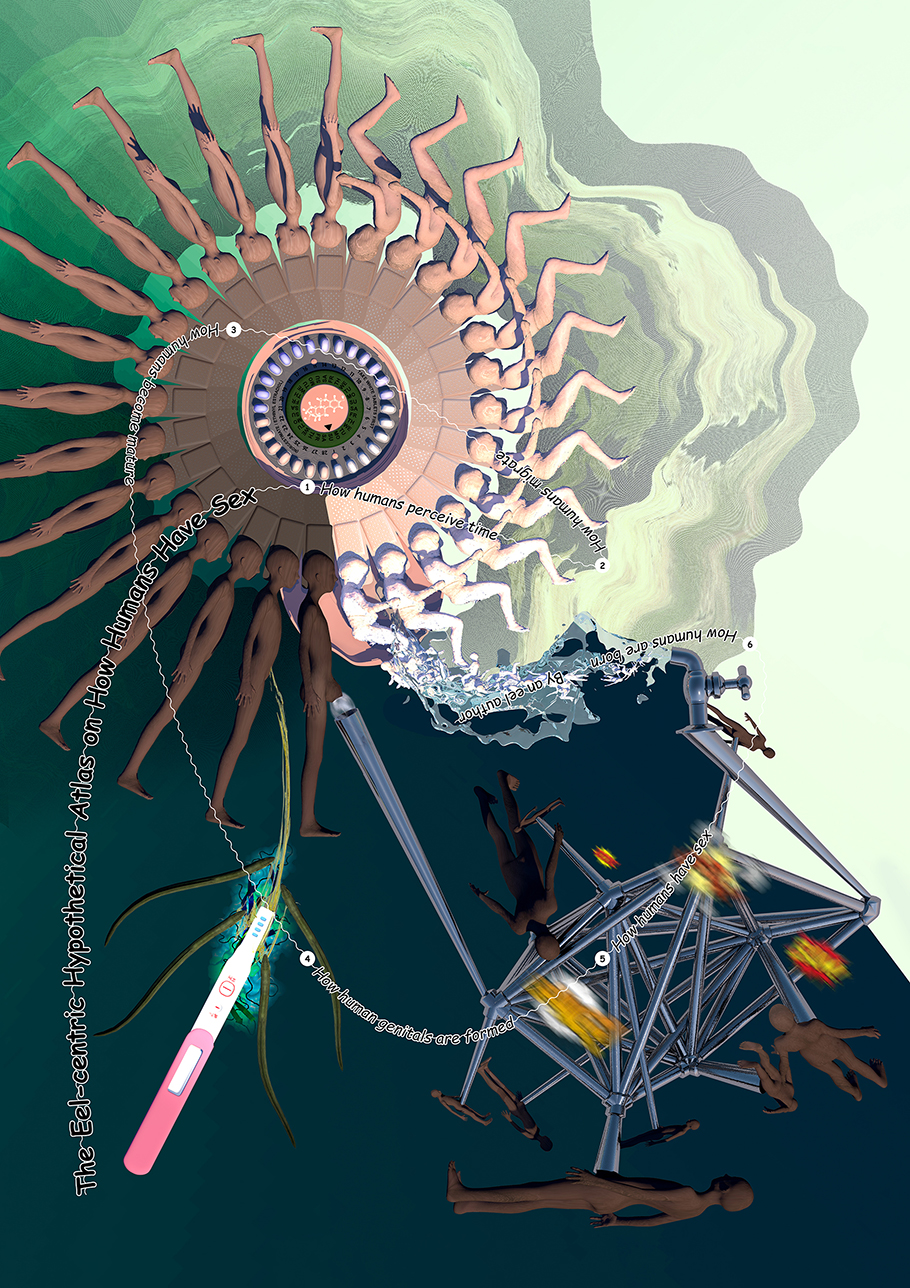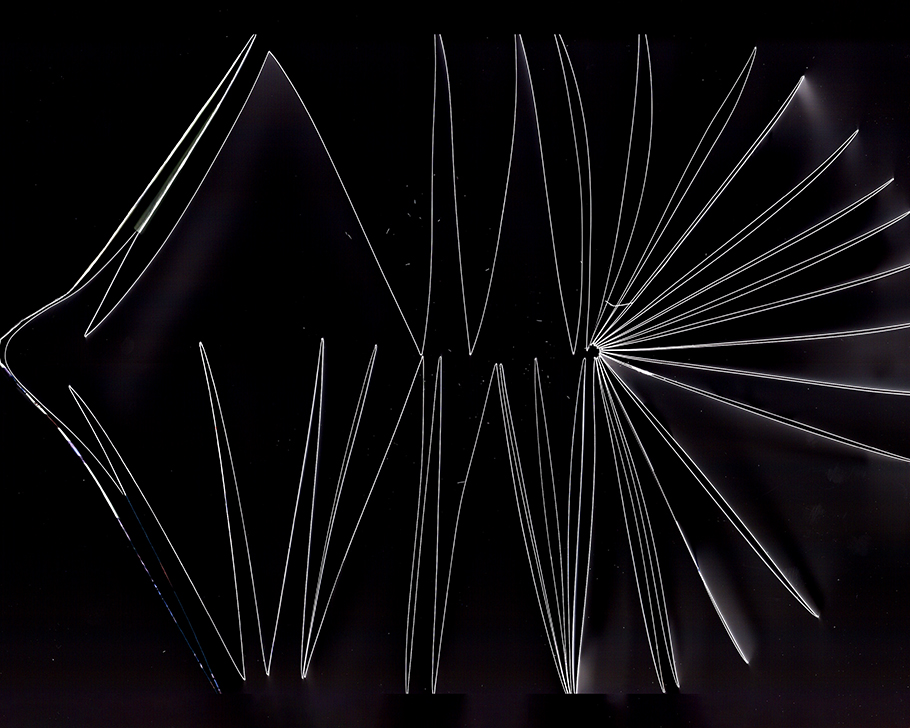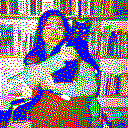The hypothetical eel-centric atlas on how humans have sex
Graduation project at Design Academy Eindhoven, Cum Laude, Communication Department

A cognitive map, that illustrates what the reproductive cycle of a human is like and how the objects that are found by eels play roles in this
"The hypothetical eel-centric atlas on how humans have sex" is a publication exploring how an eel imagines the sexual intercourses of humans. The premise here was that eels don't know what human genitals are like, considering that it was only after the 20th century that humans discovered the genitals of eels. However, the ocean that they live in is full of human-made objects and debris, so I assumed that would be the primary source of information for eels to research humans. So eels used these found object to reconstruct the human world in their cognitive space, forming their answers to every question related to the reproduction of humans, such as How humans perceive time, How humans migrate, How humans become mature, How human genitals are formed, How humans have sex, How humans are born.
According to the research of an eel, humans travel through a circular path throughout their life. Their skin gets darker as they grow old, rely on a contraceptive pill container as a time system, urinate on a pregnancy test to see if they're mature enough for having sex, Build an infrastructure for huge group sex consisting of pipes with water propagating sperms and eggs, and everyone dies after having the intercourse. Newborn humans are born from the spawning water, and released from the irrigation system through a faucet.
If eels communicate this knowledge to humans, it's very unlikely to happen in a literal way. What we share in common with eels is that the biggest part of our brain cortex is dedicated to vision. It is logical that this publication should narrate the eel-knowledge in a visual way. So it is in the form of a cognitive map, that illustrates what the reproductive cycle of a human is like and how the objects that are found by eels play roles in this. And a book here describes that cycle in detail, also by using images primarily. The book has a circular structure without page numbers and apparent beginning and end when it's unfolded as a representation of the perspective of eels formed by iterative lifecycles.
What we share in common with eels is that the biggest part of our brain cortex is dedicated to vision. It is logical that this publication should narrate the eel-knowledge in a visual way.
I've obsessively read about the ecology of freshwater eels. What fascinated me initially was the fact that no human has ever witnessed eels having sex in nature. There has been a long history of humans who questioned how eels have sex, starting from Aristotle, who thought eels are sexless and emerge from earthworms.
Now we know much more about eels than back then. Eels are delicious and therefore, a very attractive commodity for humans. This aspect has been a driving force for humans to invest more resources into eel-research. Now we know where eels have sex, what kind of hormones and conditions are involved during eels' migration to have sex, however there's still a vast area that we don't understand. Our obsession with identifying their sexual life hasn't been very successful so far. In this history of the eel-human relationship, humans have perceived eels as an inert object with high commercial value, and themselves as "curious subject". The aim of my project was to subvert this relationship of inert object and knowing subject, by making an eel speculate about humans and ask back the question. What if eels also have been questioning how humans have sex?
In order to speculate about this question, I had to study what it means to have a perspective of an eel. It was research about the sensory system of eels, what they can see, hear, smell, taste, feel about humans, and more importantly, what kind of eel-centric biases they have, coming from their life experiences such as migration and metamorphosis.
The intercourse of humans, speculated by eels, might not align with what we experience as humans. The cognitive reconstruction of the human world by eels provides readers an opportunity to deviate from their deep-rooted anthropocentrism.







Portfolio - Noam Youngrak Son
For a more visual overview, check my Instagram.
| Image | Title | Category | Year | Notes | Funding |
|---|
Noam Youngrak Son is a communication designer, design theorist, and cultural worker. Their design work encompasses small-scale publishing projects, speculative worldbuilding, workshops, lectures, writing, net art, and occasional performative interventions. As a cultural worker, they have co-organized the Ghent-based queer publishing collective Bebe Books since 2021. Son has expanded their focus from design to theory in order to critically engage with the ontology of the design industry, media, and broader material culture. This turn is informed by their observations of cultural assemblages that echo the extractive operations of capitalism on racialized and more-than-human populations. They are particularly attentive to the interconnected notions of speculation—both as an open artistic approach and as a process of value increase in capitalism. They research the tendency of the former in design to be subjugated by the latter and explore alternative methods for speculative design practices to realize their transindividual potential through collective organization and workshop facilitation. In this process, Son utilizes queer publishing as a technology for mobilizing attention beyond the financialized “scarce resource” of the attention economy. In this context, publishing extends beyond mere printed matter to encompass the maintenance of communities and the cultivation of interspecies relationships. The term "queer" here is not used as a statement of identity but as a process—small yet collective strategies of publishing that challenge the modern myth of the heroic designer.
Subscribe to the newsletter
